Multi-Phase Friction and Wear Reduction by Copper Nanopartices
Abstract
:1. Introduction
2. Materials and Methods
2.1. Lubricant
2.2. Microtribometry—Materials and Test Program
2.3. Macrotribometry—Materials and Test Program
2.3.1. Sliding Friction Tests with Radionuclide Technique
2.3.2. Rolling Friction Tests
2.4. Microscopy and Physico-Chemical Analysis
2.5. Summary of Test Conditions, Samples, and Oils
3. Results
3.1. Structure Analysis
3.2. Tribological Microscale Analysis
3.3. Tribological Macroscale Analysis
3.3.1. Sliding Friction and Wear Tests
3.3.2. Rolling Friction and Wear Tests
3.4. Physico-Chemical and Viscosity Analysis
4. Discussion
5. Conclusions
- The protective and friction-reducing action of copper-based additives can be extended to the tribological regime at ultra-low wear rates.
- Garkunov demonstrated that the surface is covered by a copper film. However, in contrast to previous research, the copper film in the current work has a thickness in the nanometer range. Whereas under severe wear, thick films are necessary to protect the surfaces, in more realistic and representative ultra-low wear regimes, thin films provide sufficient protection. However, when the ultra-low wear regime protection is exposed to severe wear conditions unrepresentative of the actual field environment, the copper additive fails to protect the surfaces. This highlights the issue of how important it is to use appropriate laboratory screening test methods that truly simulate actual field test conditions.
- In addition to copper plating, third body formation plays an important role in friction and wear reduction.
- A polymeric film with a thickness of several nanometers protects the copper tribofilm and third body from oxidation.
Acknowledgments
Author Contributions
Conflicts of Interest
References
- Garkunov, D.N. Scientific discoveries in tribo technologies. In No-Wear Effect under Friction: Hydrogen Wear of Metals; MAA Publishing House: Moscow, Russia, 2007. [Google Scholar]
- Zhou, J.; Wu, Z.; Zhang, Z.; Liu, W.; Xue, Q. Tribological behavior and lubricating mechanism of Cu nanoparticles in oil. Tribol. Lett. 2000, 8, 213–218. [Google Scholar] [CrossRef]
- Zhang, M.; Wang, X.; Liu, W.; Fu, X. Performance and anti-wear mechanism of Cu nanoparticles as lubricating oil additives. Ind. Lubr. Tribol. 2009, 61, 311–318. [Google Scholar] [CrossRef]
- Yu, H.; Shi, P.; Xu, B.; Wang, X.; Liu, Q. Tribological properties and lubricating mechanisms of Cu nanoparticles in lubricant. Trans. Nonferr. Met. Soc. China 2008, 18, 636–641. [Google Scholar] [CrossRef]
- Zhou, J.; Yang, J.; Zhang, Z.; Liu, W.; Xue, Q. Study on the structure and tribological Properties of surface-modified Cu Nanoparticles. Mater. Res. Bull. 1999, 34, 1361–1367. [Google Scholar] [CrossRef]
- Yu, H.; Xu, Y.; Shi, P.; Xu, B.; Wang, X.; Liu, Q.; Wang, H. Characterization and nano-mechanical properties of tribofilms using Cu nanoparticles as additives. Surf. Coat. Technol. 2008, 203, 28–34. [Google Scholar] [CrossRef]
- Yang, G.; Chai, S.; Xiong, X.; Zhang, S.; Yu, L.; Zhang, P. Preparation and tribological properties of surface modified Cu nanoparticles. Trans. Nonferr. Met. Soc. China 2012, 22, 366–372. [Google Scholar] [CrossRef]
- Liu, G.; Li, X.; Qin, B.; Xing, D.; Guo, D.; Fan, D. Investigation of the mending effect and mechanism of copper nano-particles on a tribologically stressed surface. Tribol. Lett. 2004, 17, 961–966. [Google Scholar] [CrossRef]
- Zhang, C.; Zhang, S.; Song, S.; Yang, G.; Yu, L.; Wu, Z.; Li, X.; Zhang, P. Preparation and tribological properties of surface-capped copper nanoparticle as a water-based lubricant additive. Tribol. Lett. 2014, 54, 24–33. [Google Scholar] [CrossRef]
- Tarasov, S.; Kolubaev, A.; Belyaev, S.; Lerner, M.; Tepper, F. Study of friction reduction by nanocopper additives to motor oil. Wear 2002, 252, 63–69. [Google Scholar] [CrossRef]
- Scherge, M.; Martin, J.M.; Pöhlmann, K. Characterization of wear debris of systems operated under low wear-rate conditions. Wear 2006, 260, 458–461. [Google Scholar] [CrossRef]
- Padgurskas, J.; Rukuiza, R.; Prosycevas, I.; Kreivaitis, R. Tribological properties of lubricant additives of Fe, Cu and Co nanoparticles. Tribol. Int. 2013, 60, 224–232. [Google Scholar] [CrossRef]
- Pilkington, G.A.; Briscoe, W.H. Nanofluids mediating surface forces. Adv. Colloid Interface Sci. 2012, 179–182, 68–84. [Google Scholar] [CrossRef] [PubMed]
- Bulgarevich, S.B.; Boiko, M.V.; Feizova, V.A.; Akimova, E.E. Effect of pressure on chemical reactions in the zone of direct friction contact of systems with selective transfer. J. Frict. Wear 2011, 32, 145–149. [Google Scholar] [CrossRef]
- Albrecht, E.; Mamykin, S.M. Composition Lubrifiante. European Patent EP2626405A1, 14 August 2013. [Google Scholar]
- Scherge, M.; Linsler, D.; Schlarb, T. The running-in corridor of lubricated metal-metal contacts. Wear 2015, 342–343, 60–64. [Google Scholar] [CrossRef]
- Scherge, M.; Pöhlmann, K.; Gerve, A. Wear measurement using radionuclide-technique (RNT). Wear 2003, 254, 801–817. [Google Scholar] [CrossRef]
- Ogletree, D.F.; Carpick, R.W.; Salmeron, M. Calibration of Frictional Forces in Atomic Force Microscopy; Departmental Papers (MEAM), Paper 96; University of Pennsylvania: Philadelphia, PA, USA, 1996. [Google Scholar]
- Varenberg, M.; Etsion, I.; Halperin, G. An improved wedge calibration method for lateral force in atomic force microscopy. Rev. Sci. Instrum. 2003, 74, 3362–3367. [Google Scholar] [CrossRef]
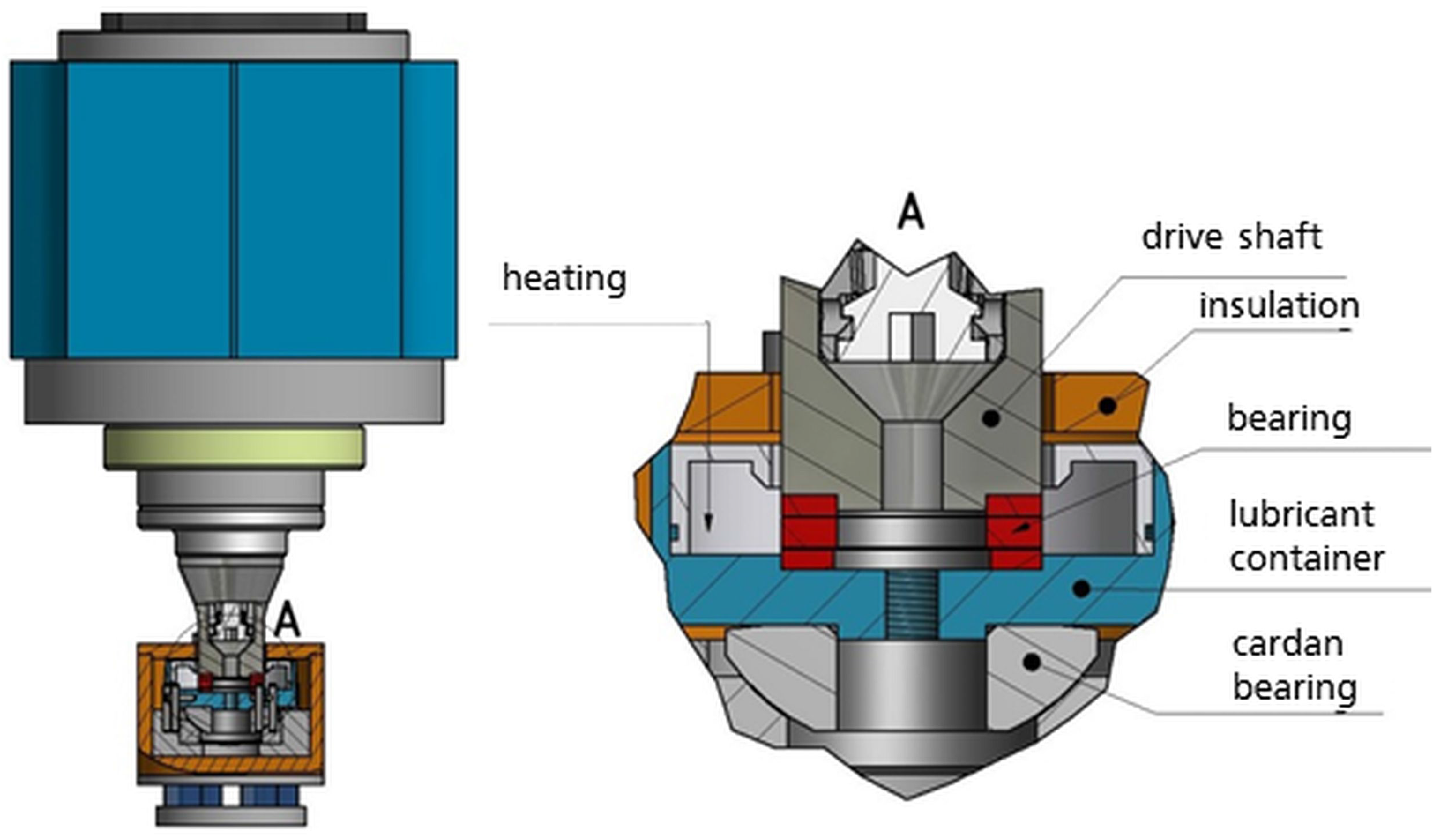

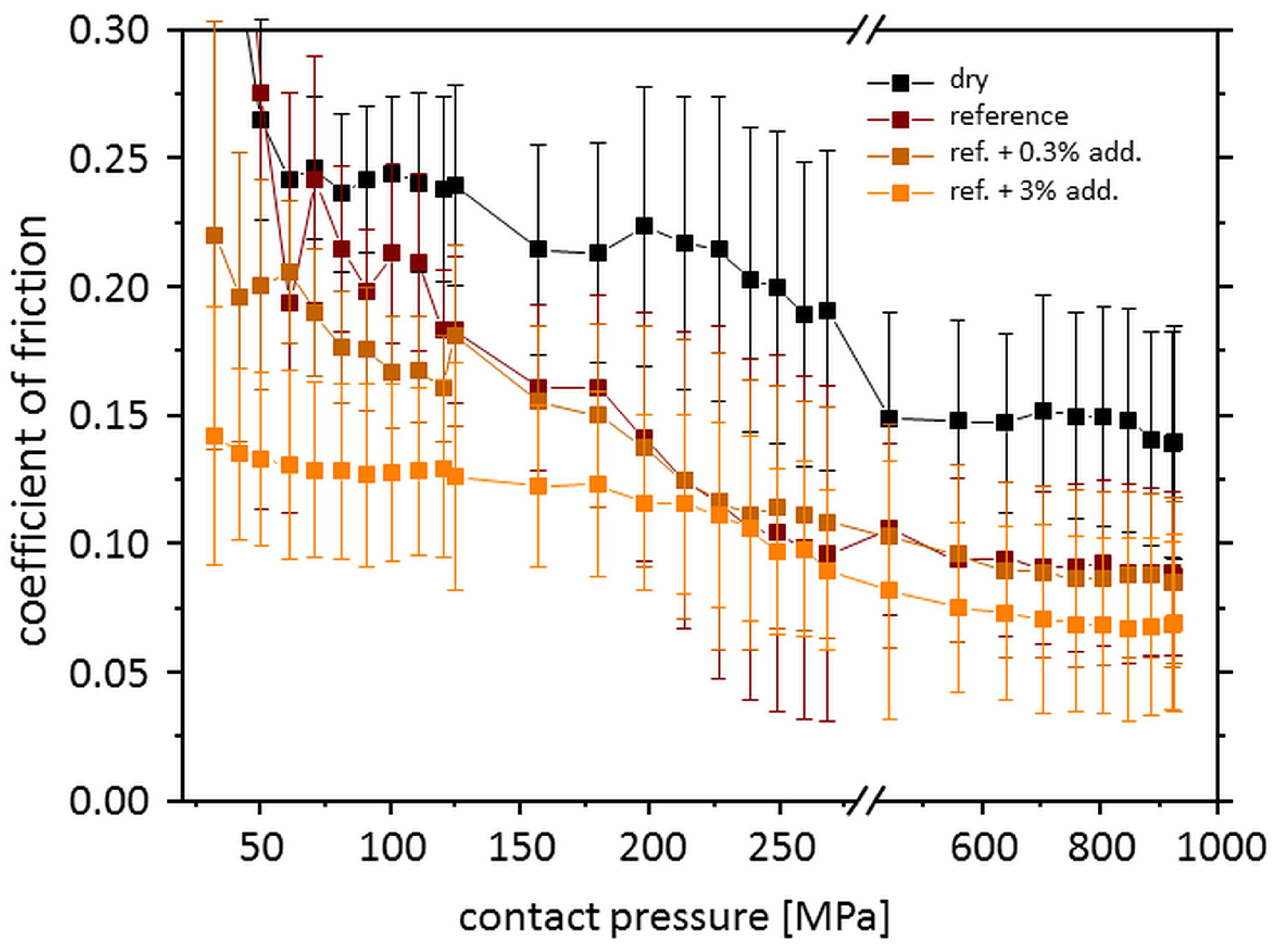
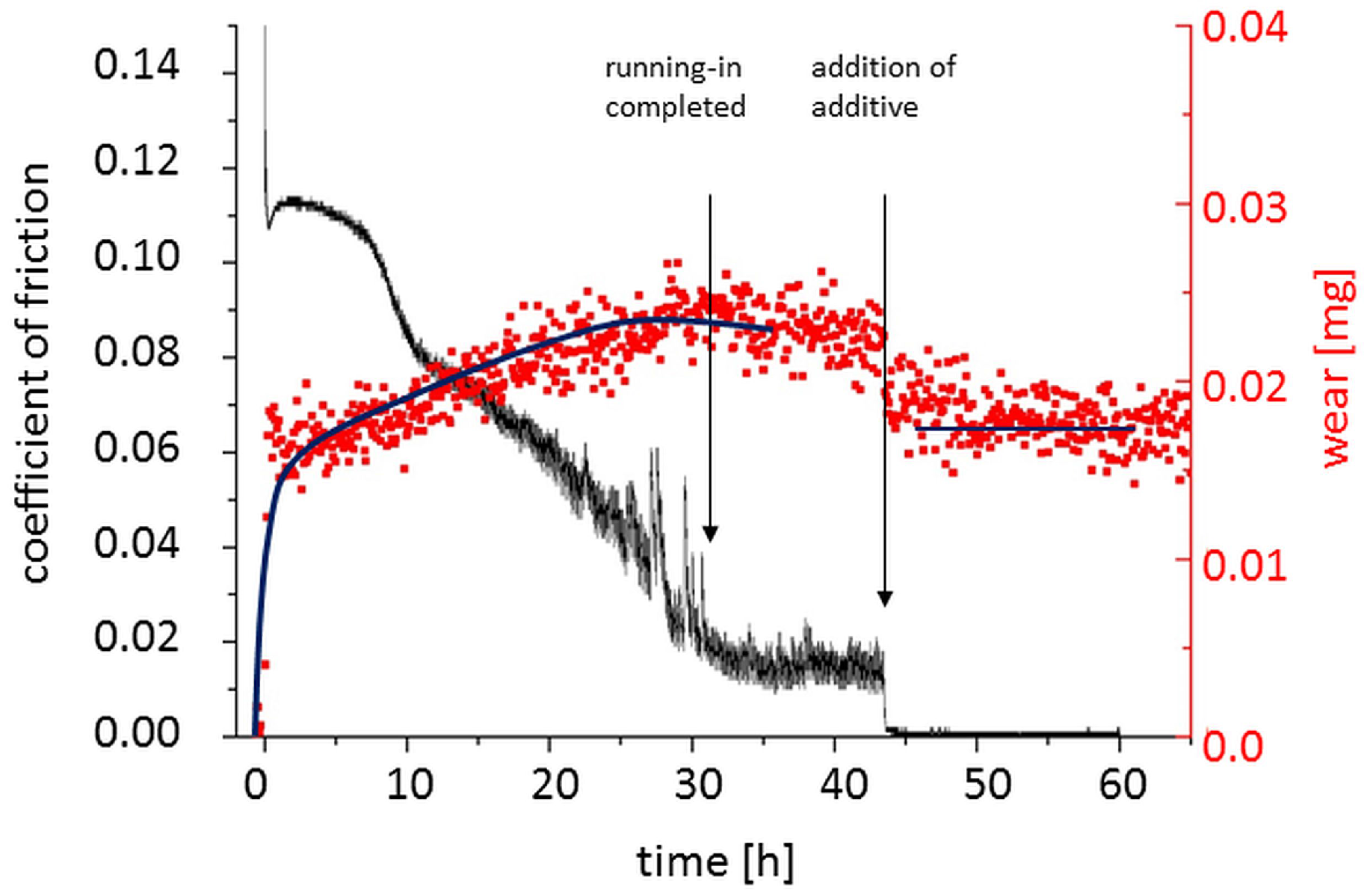
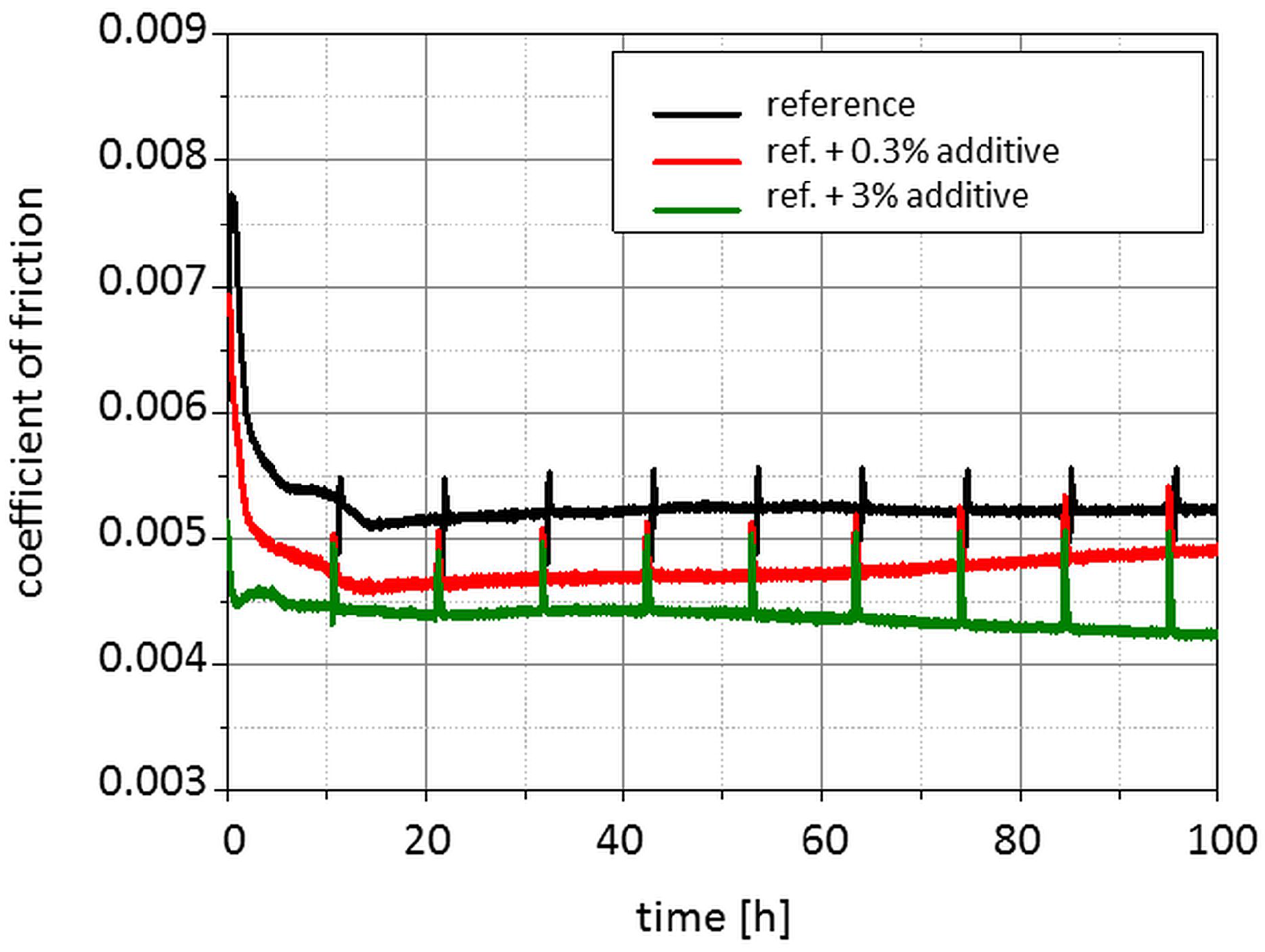
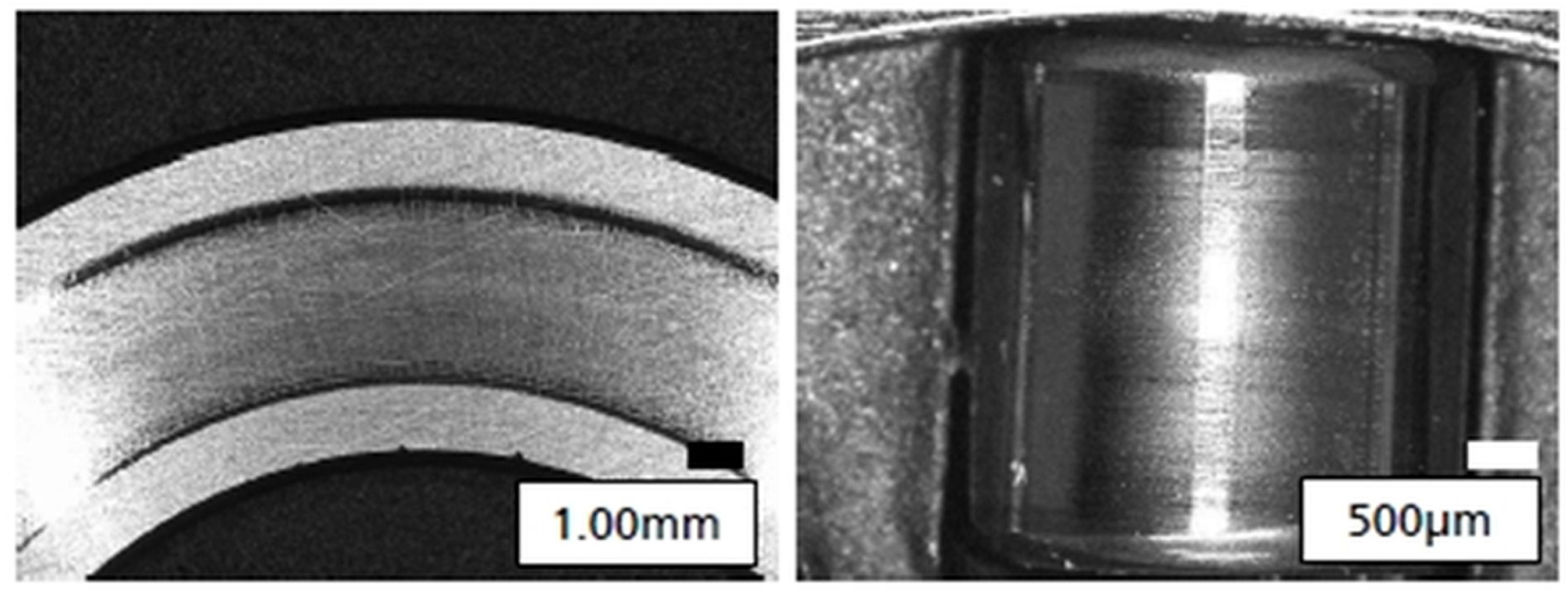

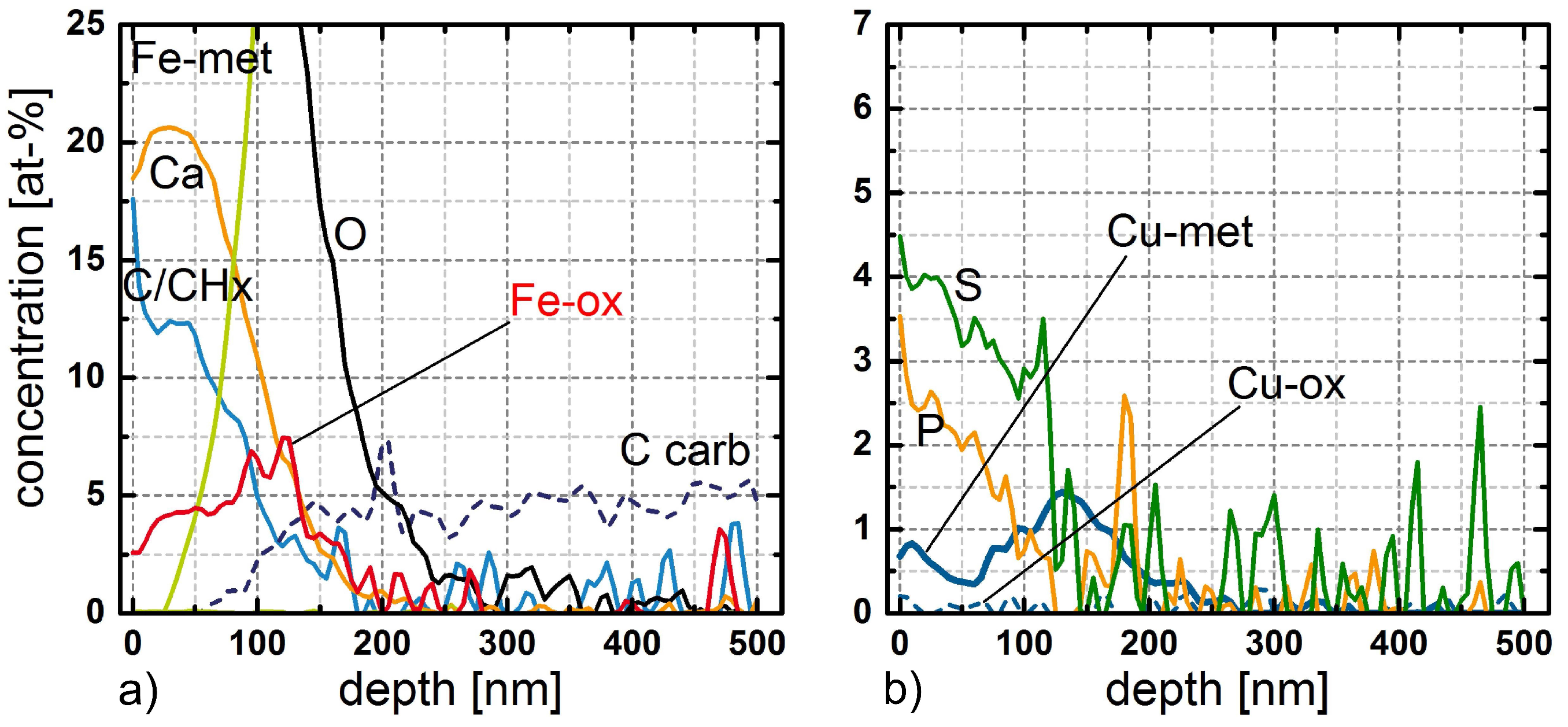


| Ranges | ||||
|---|---|---|---|---|
| Nano | Micro | Sliding ← Macro → Rolling | ||
| device | AFM | microtribometer | pod tester | thrust bearing tester |
| motion | oscillation | oscillation | rotation | rotation |
| sample | silicon/cast iron | steel | cast iron | steel |
| counter sample | Si3N4 | sapphire | chromium | steel |
| contact pressure | MPa | MPa | MPa | GPa |
| sliding velocity | μm/s | μm/s | m/s | m/s |
| reference oil | Teboil Ward | Chevron Taro 30 DP 40 | Teboil Ward | Chevron Taro 30 DP 40 |
| oil temperature | room temperature | room temperature | 120 °C | 115 °C |
| additive concentration (vol %) | 3% | 3% | 0.3% | 3% |
© 2016 by the authors; licensee MDPI, Basel, Switzerland. This article is an open access article distributed under the terms and conditions of the Creative Commons Attribution (CC-BY) license (http://creativecommons.org/licenses/by/4.0/).
Share and Cite
Scherge, M.; Böttcher, R.; Kürten, D.; Linsler, D. Multi-Phase Friction and Wear Reduction by Copper Nanopartices. Lubricants 2016, 4, 36. https://doi.org/10.3390/lubricants4040036
Scherge M, Böttcher R, Kürten D, Linsler D. Multi-Phase Friction and Wear Reduction by Copper Nanopartices. Lubricants. 2016; 4(4):36. https://doi.org/10.3390/lubricants4040036
Chicago/Turabian StyleScherge, Matthias, Roman Böttcher, Dominik Kürten, and Dominic Linsler. 2016. "Multi-Phase Friction and Wear Reduction by Copper Nanopartices" Lubricants 4, no. 4: 36. https://doi.org/10.3390/lubricants4040036
APA StyleScherge, M., Böttcher, R., Kürten, D., & Linsler, D. (2016). Multi-Phase Friction and Wear Reduction by Copper Nanopartices. Lubricants, 4(4), 36. https://doi.org/10.3390/lubricants4040036






